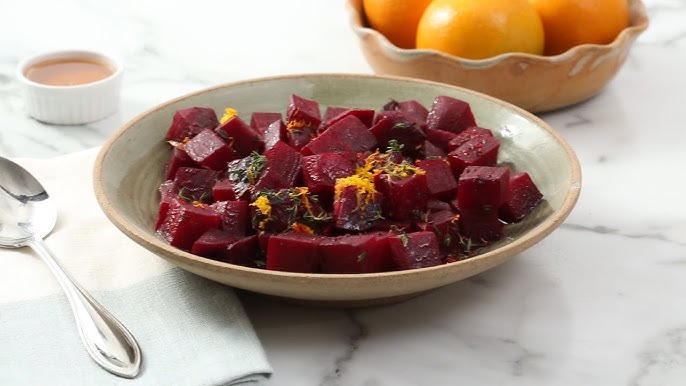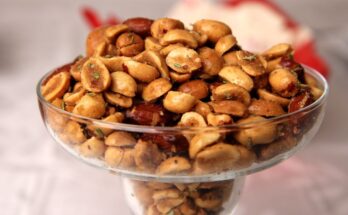Roasted Beets Recipe: Beets may be an underrated vegetable, but when roasted, they transform into a sweet, earthy, and utterly delicious side dish. Whether you’re a seasoned chef or a newbie in the kitchen, this roasted beets recipe is straightforward, nutritious, and packed with flavor. Beets are also a nutritional powerhouse, full of vitamins, minerals, and antioxidants that support overall health.
This guide will walk you through everything you need to know about roasting beets to perfection, from selecting the right ones to serving them in creative ways. By the end, you’ll have a recipe that’s not only foolproof but also easily adaptable to suit your preferences.
What You’ll Need
Before you begin, gather your ingredients and tools. Preparation is key!
Ingredients:
- 4 medium-sized fresh beets
- 2 tablespoons olive oil
- 1 teaspoon salt
- 1/2 teaspoon black pepper
Tools and Equipment:
- A sharp knife
- Cutting board
- Baking sheet or roasting pan
- Aluminum foil or parchment paper
- Mixing bowl
- Oven mitts
Having these essentials on hand will make the process smooth and enjoyable.
Choosing the Right Beets
Not all beets are created equal. To ensure the best results, here’s what to look for:
- Freshness: Choose beets that are firm and smooth, with no visible bruises or soft spots.
- Size: Medium-sized beets are ideal for roasting as they cook evenly. Avoid oversized beets, which can be woody and less flavorful.
- Greens Attached: If possible, opt for beets with vibrant green leaves still attached, as this is a sign of freshness.
For variety, you can try golden or striped beets alongside the classic red ones. Each type has a unique flavor and aesthetic appeal.
Preparing Beets for Roasting
Proper preparation is critical to achieving perfect roasted beets. Here’s how to get them ready:
- Cleaning: Start by rinsing the beets thoroughly under running water to remove dirt and debris. Beets grow in soil, so don’t skip this step.
- Trimming: Cut off the beet greens (you can save them for another recipe) and trim the root ends.
- Peeling: You can peel the beets before or after roasting. If peeling beforehand, use a vegetable peeler. Roasted skins, however, slide off easily once the beets are cooked.
- Cutting: For even cooking, cut the beets into uniform sizes—halves or quarters for larger beets, and leave smaller ones whole.
Taking a few extra minutes to prepare the beets properly will make a noticeable difference in the outcome.
Seasoning Your Beets
Seasoning is where you can get creative. While the basic salt, pepper, and olive oil combination is a classic, there’s plenty of room to experiment:
- Basic Seasoning: Drizzle olive oil over the beets, sprinkle with salt and pepper, and toss to coat evenly.
- Flavor Enhancements: Add a splash of balsamic vinegar or a sprinkle of garlic powder for extra depth.
- Herbs: Fresh rosemary, thyme, or dill pair wonderfully with roasted beets.
Mix the seasonings in a bowl before tossing the beets to ensure every piece is well-coated.
How to Roast Beets – Step-by-Step Instructions
Follow these simple steps to roast your beets to perfection:
- Preheat the Oven: Set your oven to 400°F (200°C). A hot oven is key to achieving caramelized edges.
- Prepare the Baking Sheet: Line the sheet with aluminum foil or parchment paper for easy cleanup.
- Arrange the Beets: Spread the beet pieces in a single layer on the baking sheet, ensuring they don’t overlap. Crowding the pan will result in steaming instead of roasting.
- Roast the Beets: Place the baking sheet in the preheated oven. Roast for 35–45 minutes, flipping halfway through for even cooking.
- Check for Doneness: Pierce the beets with a fork. They’re ready when the fork slides in easily without resistance.
By now, your kitchen will be filled with the earthy aroma of roasted beets—a sign of good things to come.
How to Check Doneness
Knowing when your roasted beets are perfectly cooked is crucial to avoid undercooking or over-roasting. Here’s how to check for doneness:
- Fork Test: Insert a fork or skewer into the thickest part of the beet. If it slides in smoothly without resistance, the beets are ready.
- Texture: The ideal texture is tender but firm enough to hold its shape when sliced. Avoid roasting to the point where the beets turn mushy.
- Visual Cues: Beets will shrink slightly during roasting, and the edges might caramelize. This is a good indicator that they’re ready to come out of the oven.
If they’re not quite done, pop them back into the oven for another 5–10 minutes and check again.
Serving Suggestions
Roasted beets are incredibly versatile and can be enjoyed in numerous ways. Here are some serving ideas to inspire you:
- Simple Side Dish: Serve the roasted beets warm, drizzled with a little olive oil or balsamic glaze. Sprinkle with fresh herbs like parsley or thyme for added freshness.
- Salads: Add roasted beets to a green salad with goat cheese, walnuts, and arugula for a sweet and savory combination.
- Grain Bowls: Toss the beets into a quinoa or farro bowl with roasted vegetables, chickpeas, and tahini dressing.
- Toppings: Use roasted beets as a topping for avocado toast, pizza, or even as a component in a charcuterie board.
The vibrant color and earthy flavor make roasted beets a showstopper on any table.
Storage and Reheating Tips
If you have leftovers, roasted beets store well and retain their flavor when handled properly. Follow these tips:
- Storing: Place the cooled beets in an airtight container or wrap them tightly in aluminum foil. Store them in the refrigerator for up to 5 days.
- Freezing: For longer storage, freeze roasted beets in a resealable freezer bag. They’ll keep for up to 3 months. Thaw in the fridge before reheating.
- Reheating: Warm the beets in the oven at 350°F (175°C) for 10–15 minutes. Alternatively, reheat them in a skillet over medium heat with a touch of olive oil.
These tips ensure you can enjoy roasted beets whenever you like without compromising taste or texture.
Health Benefits of Eating Beets
Beets are not just delicious—they’re also packed with nutrients that contribute to a healthy lifestyle. Here’s why you should include roasted beets in your diet:
- Rich in Nutrients: Beets are an excellent source of fiber, folate, potassium, and vitamin C.
- Heart Health: The nitrates in beets help lower blood pressure and improve circulation, supporting cardiovascular health.
- Digestive Health: The fiber in beets promotes gut health and aids digestion.
- Antioxidants: Beets are rich in betalains, powerful antioxidants that help fight inflammation and oxidative stress.
- Energy Boost: The natural sugars in beets provide a quick energy boost, making them a great pre-workout snack.
Roasted beets retain most of these nutrients, making them a wholesome addition to any meal.
Common Mistakes to Avoid
Even simple recipes can go wrong if you’re not careful. Avoid these common pitfalls when roasting beets:
- Skipping the Wash: Beets grow underground, so failing to wash them thoroughly can result in a gritty texture.
- Overcrowding the Pan: Crowding prevents even cooking and caramelization. Use a large baking sheet or roast in batches.
- Peeling Before Roasting: While peeling is optional, leaving the skin on during roasting helps preserve moisture and flavor.
- Overcooking: Beets that are roasted too long can become dry and lose their vibrant flavor.
- Undersalting: Beets have a naturally sweet flavor, so don’t skimp on salt to balance the taste.
With these tips, you’ll avoid rookie mistakes and ensure your roasted beets turn out perfect every time.
Variations and Add-Ons
Want to switch things up? Here are some creative variations and add-ons to make your roasted beets even more exciting:
- Spices: Sprinkle cumin, smoked paprika, or chili powder for a bold, smoky flavor.
- Citrus Zest: Add grated orange or lemon zest after roasting for a zesty twist.
- Honey Glaze: Drizzle honey or maple syrup during the last 10 minutes of roasting for extra caramelization.
- Cheese: Serve with crumbled feta or goat cheese for a creamy contrast.
- Nuts: Top with toasted almonds, walnuts, or pistachios for a crunchy texture.
These variations allow you to tailor the recipe to your taste preferences and make roasted beets a regular part of your menu.
FAQs about Ribeye Roast Recipe
1. What is the best temperature to cook a ribeye roast?
Cooking a ribeye roast perfectly involves roasting it at a moderate temperature to ensure it’s evenly cooked. Preheat your oven to 350°F (175°C) for the best results. This temperature allows the roast to cook slowly, enhancing its natural flavors and tenderness.
2. How long should I cook a ribeye roast?
The cooking time for a ribeye roast depends on how well-done you prefer your meat. Generally, aim for about 20 minutes per pound for medium-rare. Always use a meat thermometer to check that the internal temperature has reached 135°F (57°C) for medium-rare or 145°F (63°C) for medium.
3. Should I sear my ribeye roast before roasting?
Yes, searing the ribeye roast before roasting is highly recommended. Searing it on all sides in a hot skillet helps to lock in the juices and gives the roast a delicious, caramelized crust.
4. What herbs and spices work well with a ribeye roast?
Rosemary, thyme, garlic, and black pepper are excellent choices for seasoning a ribeye roast. These herbs and spices complement the rich flavors of the meat without overpowering it.
5. How do I keep my ribeye roast moist while cooking?
To keep your ribeye roast moist, ensure not to overcook it. Keeping a tray of water in the oven during the roasting process can also help maintain moisture. Additionally, basting the roast periodically with its juices can promote a juicy, flavorful finish.
6. Can I cook vegetables with my ribeye roast?
Absolutely! Roasting vegetables in the same pan as your ribeye roast is a great way to absorb all the flavors. Potatoes, carrots, and onions make for a hearty and convenient side dish that cooks as your roast does.
7. What should I do with leftovers?
Leftover ribeye roast can be stored in an airtight container in the refrigerator for up to three days. Reheat it gently, or use it cold in sandwiches, salads, or wraps for a delicious next-day meal.
Conclusion
Roasting beets is a simple yet rewarding way to bring out their natural sweetness and earthy flavor. Whether you’re enjoying them as a side dish or incorporating them into other recipes, roasted beets are sure to elevate your meals. Now that you have all the tips and tricks, it’s time to get in the kitchen and give this recipe a try. You won’t regret it!



